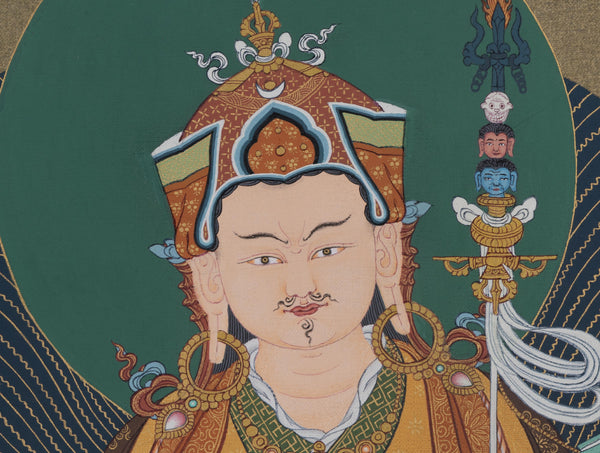“The Vajrayogini yoga method is extremely powerful. It is just what we need in these degenerate times, with our delusions running rampant and our minds grasping at concretized sense pleasures. Therefore, a method such as this, which has the wisdom to transform delusions, is of the utmost need, especially as it has the profound property of becoming more powerful as delusions become stronger.” – Lama Yeshe
Embodiment of the Cognitive Functions
Vajrayogini is also known as Vajravarahi in Vajrayana, or Tantric Buddhism. And who is Vajrayogini? To put the answer simply, the female embodiment of the cognitive functions that lead to Buddhahood is in fact Vajrayogini herself. Vajrayogini practice has always emphasized experience over speculation. However, the terms of speculative philosophical Buddhism are used in an imaginative manner.
Iconographical Representation
Vajrayogini is usually depicted in a terrifying form in iconographical representations. She is depicted as holding a skull and a dagger in her hands, with her right leg stretched out, and the left one slightly bent (alidha). Cremation grounds surround her from all sides. It indicates that the ordinary world has become dead. It contrasts the rich world of inner life and its vision of reality without distorting fictions.
She is usually seen in union (yab-yum) with Heruka, even though she is visualized alone.
Heruka is known as Hevajra when he is united with Vajrayogini. As such he is very popular in Tibet. In particular, he is popular amongst the Bka’-brgyud-pa, a major Buddhist sect that considers him their tutelary deity.
Various Emanations
Vajrayogini may be accompanied by other aspects of herself, which is an expression of the multiplicity of psychic phenomena. Such as, Vajravairocani, as in “She Who Reveals,” and is colored yellow like the all-illuminating sun. Or Vajravarnani, “She Who Colors,” colored green. It symbolizes the widest range of perception, as well as the fact that man’s view is “colored.” In her principal form, Vajrayogini is also known as Vajradakini in her principal form, as in “She Who Roams over the Void.”
In spite of her importance in Vajrayana Buddhism, Vajrayogini does not figure as the main deity of a tantra (literary work). There are four sadhanas (methods of visualization) describing her various forms.
Vajrayogini in Today’s Dissipated Times
Of all the Vajrayana meditative deities, Vajrayogini is credited with being the one practice for our busy, hectic, terrifying times, among all the other Vajrayana meditative deities. It can ultimately lead us, in one lifetime, to Enlightenment. Her visualization, appearance, mantra, and sadhana are all intrinsically designed to combat our modern obstacles. More precisely, the obstacles of our dissipated times. In our modern age, life is very hectic we have no time.
Life is always in the way of practice, and we struggle with many fears, including, but not limited to, terrorism, global warming, wars, capitalism, paying the bills, healing our sickness, and whatnot. These are all the reasons to consider her practice. Her practice will not just free us from the prisons of our minds but will actually help us look into and understand the inherent flaws in our socio-political superstructure and to actively resist its ideological submission. By not adhering to the norms or confirming to this ideology, we will have separated ourselves from its illusions and will finally be able to get rid of our delusions.
Ten Benefits of Practice According to Root Tantra
The source Tantra, in the Condensed Root Tantra of Heruka, explains there are ten key spiritual benefits to practice, many not available from other practices:
- Easy to practice: although a Highest Yoga Tantra practice, the visualization of the mandala is “relatively” easy, the sadhanas are “relatively” short and the mantra is “relatively” easy. Relatively being the key word.
- Ideal for this “degenerate” age: Unlike other practices, Vajrayogini brings fast benefits, since Heruka and Her mandalas are closer to us than other deities.
- Vajrayogini’s mantra is supreme for attainments. Although somewhat long, it is easy to memorize. It is said that Vajrayogi’s mantra alone is all a practitioner would ever need, provided they have faith.
- Powerful blessings: not just blessings, but quick blessings.
- Can accomplish all attainments: many of the great Mahasiddas accomplished Enlightenment and other realizations from Her practice.
- Can practice both generation and completion stage together: if you don’t know what this means, teacher guidance is best.
- Overcomes attachments: Vajrayogini’s sensuous nature and red colour signify she is suitable for overcome desires and cutting attachments (hence, her flaying knife!)
- Vajrayogini’s practice contains the essence of all practices even though it is short in nature.
The two of the last ones are relatively more secret because of their complexity. To put it plainly, unless one is already a practitioner, one cannot understand or fully comprehend these benefits. These are the ninth and the tenth benefits;
- Uncommon Yoga of Inconceivability
- Special body mandala practice
Practicing Vajrayogini
Vajrayogini’s practice and Vajrayogini mantra is one of the Highest Yoga Tantra that requires both permission and empowerment. It is not exclusive and anyone can honor, pray to, or meditate on her as an “external deity.” However, without initiation, one is not permitted to visualize the self as Vajrayogini and probably not to chant the mantra. Still, one can come closer to Vajrayogini’s enlightened qualities through praise, offerings and prayers, but it goes without empowerments.
Unlike other meditations, the nature of Vajrayogini’s meditation is very energetic. And even though it is designed to deal with the high pace of our “degenerate times,” it does require some guidance. Having a qualified teacher with proven lineage is the best path to Vajrayogini.


1 comment
Kamala raju
So nice and easy to get connected with the mantra and do the practice. I am already practicing the vajrayogini mantra